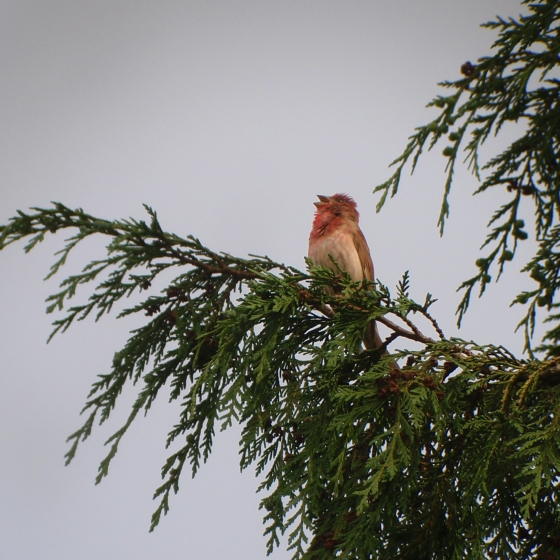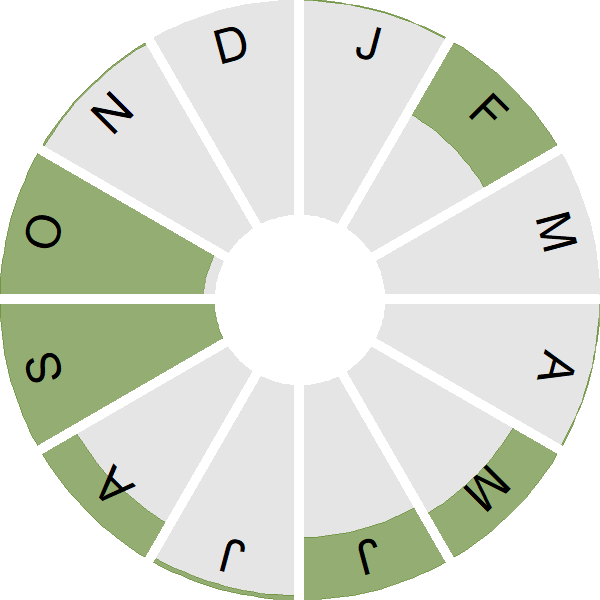Common Rosefinch

Introduction
Most encounters with this rare visitor to Britain & Ireland will not meet the colourful expectations of the bird's name, with scarce autumn migrants looking plain and brown.
Pinkish-red singing males have been found very occasionally in the UK, with the first recorded breeding in 1982 in the Highlands of Scotland. The species has bred irregularly since then with Bird Atlas 2007-11 recording possible breeding from around 25 locations, mainly in Scotland.
The Common Rosefinch is most regular as an autumn visitor in the Northern Isles, with birds regularly spending a few weeks in Shetland, and especially on Fair Isle. When studied in their first winter plumage, they are subtly streaked and have an attractive beady black eye.

Key Stats
Identification
Songs and Calls
Song:
Status and Trends
Conservation Status
Population Size
Population Change
Common Rosefinch is an occasional breeder in the UK, first breeding here in 1982 and increasing in numbers until the turn of the century when numbers declined; a pair that bred on Fair Isle in 2022 were the first to fledge young since 2001 [Eaton & the Rare Breeding Birds Panel 2024]. Although the species was predicted to become a regular breeder in the UK, its presence here coincided with a population increase across Europe and its disappearance with a subsequent decline [PECBMS: PECBMS 2020a].
Distribution
Common Rosefinches are sporadic breeders, with the first breeding record being as recent as 1982
Occupied 10-km squares in UK
2007/08–10/11
or view it on Bird Atlas Mapstore.
2008–11
or view it on Bird Atlas Mapstore.
European Distribution Map
Distribution Change
from 1981–84 to 2007–11
or view it on Bird Atlas Mapstore.
from 1968–72 to 2008–11
or view it on Bird Atlas Mapstore.
Seasonality
Common Rosefinch is a rare passage migrant, with some birds holding territory in late spring, and passage of juveniles in September and October.
Weekly pattern of occurrence
The graph shows when the species is present in the UK, with taller bars indicating a higher likelihood of encountering the species in appropriate regions and habitats.

Movement
Britain & Ireland movement
Foreign locations of birds ringed or recovered in Britain & Ireland
Dots show the foreign destinations of birds ringed in Britain & Ireland, and the origins of birds ringed overseas that were subsequently recaptured, resighted or found dead in Britain & Ireland. Dot colours indicate the time of year that the species was present at the location.
- Winter (Nov-Feb)
- Spring (Mar-Apr)
- Summer (May-Jul)
- Autumn (Aug-Oct)

European movements
EuroBirdPortal uses birdwatcher's records, such as those logged in BirdTrack to map the flows of birds as they arrive and depart Europe. See maps for this species here.
The Eurasian-African Migration Atlas shows movements of individual birds ringed or recovered in Europe. See maps for this species here.
Biology
Productivity and Nesting
Nesting timing
Egg measurements
Clutch Size
Survival and Longevity
Survival is shown as the proportion of birds surviving from one year to the next and is derived from bird ringing data. It can also be used to estimate how long birds typically live.
View number ringed each year in the Online Ringing Report.
Lifespan
Survival of adults
Survival of juveniles
Biometrics
Wing length and body weights are from live birds (source).
Wing length
Body weight
Ring Size
Classification, names and codes
Classification and Codes
- Order: Passeriformes
- Family: Fringillidae
- Scientific name: Carpodacus erythrinus
- Authority: Pallas, 1770
- BTO 2-letter code: SQ
- BTO 5-letter code: SCARO
- Euring code number: 16790
Alternate species names
- Catalan: pinsà carminat
- Czech: hýl rudý
- Danish: Karmindompap
- Dutch: Roodmus
- Estonian: karmiinleevike
- Finnish: punavarpunen
- French: Roselin cramoisi
- German: Karmingimpel
- Hungarian: karmazsinpirók
- Icelandic: Rósafinka
- Irish: Rósghlasán Coiteann
- Italian: Ciuffolotto scarlatto
- Latvian: mazais svilpis
- Lithuanian: raudongalve sniegena
- Norwegian: Rosenfink
- Polish: dziwonia (zwyczajna)
- Portuguese: peito-carmim
- Slovak: cervenák karmínový
- Slovenian: škrlatec
- Spanish: Camachuelo carminoso
- Swedish: rosenfink
- Welsh: Llinos Goch
More Evidence
More evidence from Conservation Evidence.com
Partners
Citing BirdFacts
If you wish to cite particular content in this page (e.g. a specific value) it is best to use the original sources as linked in the page. For a more general citation of the whole page please use: BTO (20XX) BirdFacts Species: profiles of birds occurring in the United Kingdom. BTO, Thetford (www.bto.org/birdfacts, accessed on xx/xx/xxxx).

